| Pictures in slideshow above were taken between 2001 and 2012, before conservation had started. |
|
Old St.Helens in 2013 & 2015
more>> |
The following text is extracted from "A Short Guide for Visitors to the Ruins of the Old Parisg Church of St Helen, Ore, Sussex" by F.W.B.Bullock, son of the Rector of Ore, 1897 - 1929 and published in 1949 (see below).
THE ancient parish church of St. Helen, Ore, became ruinous, because in 1869 it was decided to pull much of it down and to build in its stead a new parish church on a fresh site adjoining the main road about a quarter of a mile distant.
The north wall of the nave is chiefly of early Norman date ; almost in the middle of it there is a blocked doorway, probably inserted in the 14th century, above which is a small window, only some 9 inches wide, its head being constructed of a single stone ; this little window is either early Norman or Saxon ; it supplies the earliest definite evidence for a church at Ore, which must therefore have existed by about 1150 at the latest and very likely before the Norman Conquest of 1066 |
 Lithograph by Rowe / Wooll, 1820?
Lithograph by Rowe / Wooll, 1820? |
An interesting guess — for it cannot be claimed to be more than a guess — as to the origin of this church would take its story back as far as the 8th century. Offa, King of Mercia, conquered the Haestingas in the year 771 ; his favourite saint was St. Helen ; wherever he went, the name of St. Helen is found, a name common in the Midlands, rare in the South —only one other church in Sussex, that of Hangleton, near Brighton, bears her name. So the guess is that, having conquered the district around Hastings, Offa founded a Church at Ore and had it dedicated to St. Helen.
Helen (or Helena) was the wife of the Roman Emperor Constantius and the mother of the Emperor Constantine ; she was a devout Christian and was said to have discovered,when on a visit to Jerusalem, the true cross of Christ ; after her death in 328 and canonisation,many |
| churches were dedicated to her, especially in Yorkshire, Lincolnshire, Nottinghamshire and the Midlands.
Some legends assert that she was a British princess, a daughter of Old King Cole,' and that her famous son was born at York ; he was certainly acclaimed Emperor there in 306 by the Roman legions stationed in Britain.
The name Ore, which has manuscript authority as far back as the period 1121 - 5, is derived from the Old English Ora, which has been variously translated " bank," " shore,"
margin," " brink," " border," " an entrance or the beginning of something," " slope " and " ridge."
right: Postcard from around 1910
|
|
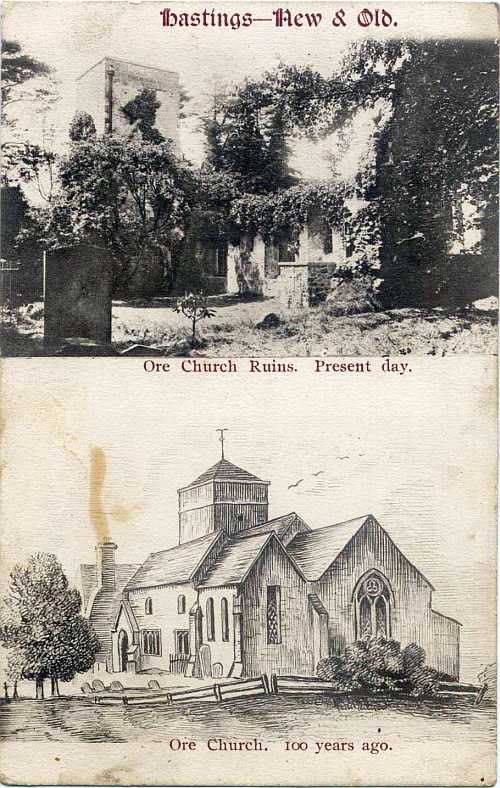
"Then and Now" postcard from around 1910 |
below: "A Short Guide for Visitors to the Ruins of the Old Parish Church of St Helen, Ore, Sussex"
by F.W.B.Bullock, 1949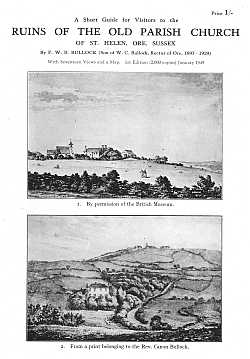
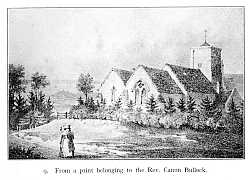
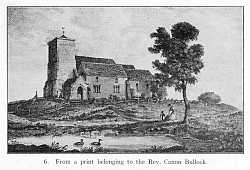
|
The earliest manuscript evidence for the existence of Ore Church is in the Ecclesiastical Valuation of England and Wales of 1291, made by the authority of Pope Nicholas IV. This states that the income of the Church of Ore did not then exceed 6s. 8d. per annum — that is, the endowed annual income of the benefice was not more than 8 marks.
Ore Church probably became a parish church with its own rector from the outset of its history, though the first proof that its incumbent was Rector of Ore dates from 1340, in the Inquisitions for Ninths in the Exchequer Court.
The names of the Rectors of Ore are not known before that of William Page de Ukfield, who left Ore on April 18, 1361, on an exchange of benefices with Peter de Archesfont.
The oldest extant manuscript evidence that Ore Parish Church was dedicated to St. Helen is in the will of 1421 of John Halle of Ore.
After the north wall with its little window, the oldest part of the ruins is the tower, which dates from the late 12th or early 13th century say, about 1200. Its style is Transitional-Norman. The top part fell into decay after 1869, but it was repaired by 1884 and re-roofed in 1904 — 5. Inside will be found the original stair turret up to the belfry stage on the north side and the Early English font, which was found in 1904 or 1905 broken in many pieces, carefully restored and placed in the corner of the old tower because it could not be used in the new church, since it was not in a condition to hold water.
Likewise of the Early English style, dating from the 13th century, is the Chancel with its two lancet windows and an arched tomb recess between them on the north side. The East window is a two-light Decorated one, belonging to the 14th century. Two windows of two lights each, as shown in early 19th century views, were inserted in the north wall of the nave, but they were replaced in the 19th century by the present two windows of three lights each in the Perpendicular style.
On the north side of the interior of the ruined building (in addition to the recess already mentioned) there are three gravestones, erected in 1905 or 6 upright against the wall, one of 14th century and two of 17th century date.
The old church for centuries consisted only of chancel, nave and western tower, but probably in the 18th century a south aisle with an overall roof was added to the nave and the western portion of the chancel with two dormer windows, each of three lights, and a porch. In 1776 Sir William Burrell stated that the church has " a nave and two small aisles and a chancel," but he evidently meant the two parts of one south aisle. By 1817, however, this aisle had been removed, though the porch survived. In 1821 a new south aisle was constructed, extending the whole length of the nave and chancel and having a separate roof. West of it was a porch, leading in to the tower. Another porch, used as a vestry, was added in the 19th century at the north-west angle of the nave. A western gallery was erected in 1816 and in 1821 the new south aisle also had a gallery ; the former was entered from the tower staircase.
On Sunday, September 7, 1902, an open-air service was held in the ruins of the ancient church ; this proved to be the first of a number of such occasions, usually one or two each year on Sunday afternoons in the summer ; for this purpose the 20th century stone pulpit was built and wooden benches were supplied for part of the congregation ; no such services were practicable during the war of 1939 — 1945, but they were revived in 1948, when two were held.
The early 19th century bell, the pitch-pipe used for starting the services, a medieval tile, the parish registers dating back to 1558, a number of 18th and 19th century memorial tablets and one magnificent monumental brass were removed to the modern parish church. A few other ancient tiles from the old church are now in the Barbican Tower at Lewes in the care of the Sussex Archaeological Society. The brass, now on the north wall of the chancel of the new church, is probably in memory of John Halle (died 1421 — 2) and Amicia his wife (died 1430), though some authorities prefer to date it about 1400.
The list of rectors is far from being complete between 1361 and 1661, but is probably perfect from 1661 to the present day. The patronage of the benefice until about 1750 followed the descent of the Manor of Ore. This passed from Robert de Ore (about 1190) and his descendants to the successive families of Halle, Sackville, Crisp, Harrington and Caryll. Afterwards the patronage passed through various hands until it was acquired in 1885 by Simeon's Trustees.
The ancient tiny window in the north wall is not depicted in any of the drawings of the old church up to and including that by Saunders in 1859. It must have been blocked up and plastered over on the outside, but on the inside it was obviously visible, for it is mentioned as a feature of interest in " Ross's Hastings and St. Leonards Guide " in the editions of 1849 onwards. It was opened up some time between 1859 and 1906, when it is clearly shown in a drawing in " The Hastings Road," by C. G. Harper.
In the churchyard was buried the body of one famous man General the Honourable James Murray, of " Beauport " and Ore Place, who died in 1794. His monumental inscription is now in the new church. |
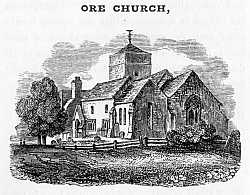
Above: from Kidd's "Picturesque Pocket Companion to Hastings" 1832
Right: A postcard from around 1910
|

|
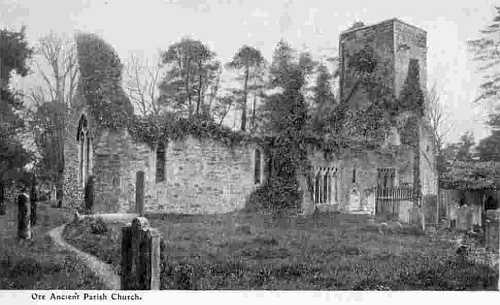 |
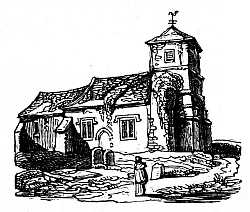
Above: from "A Concise Historical and Topographical sketch of Hastings Winchelsea and Rye published in 1817"
Left: from "Hastings & St.Leonards Souvenir" c 1910
|
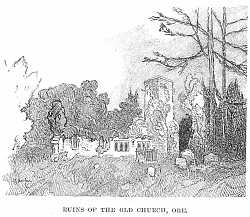
above: from Harper's "The Hastings Road" 1906
right: 1840? Lithograph by Thomas Ross, five times Mayor of Hastings |
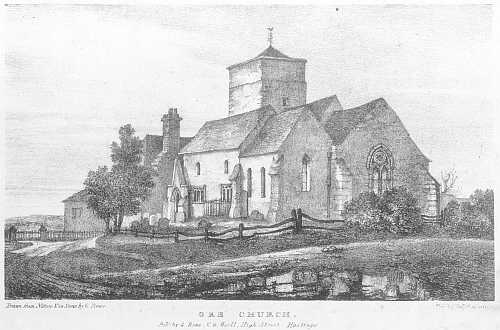 |
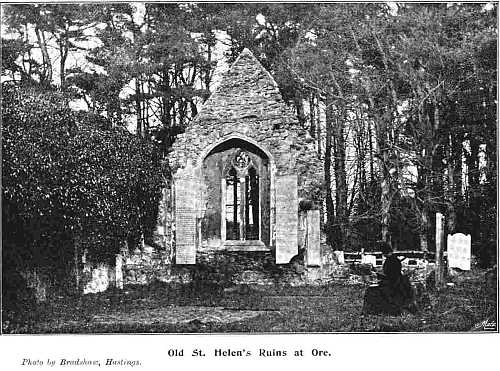 Illustration from Mate's 1900 Hastings Guide
Illustration from Mate's 1900 Hastings Guide |
Southall's Pocket Guide to St. Leonards and Hastings " (about 1836) observes : —" The church-yard is chiefly remarkable for containing the graves of five smugglers in a row, who were killed in an encounter with the revenue officers ; and of seven females, whose white tombstones,
likewise in a row, show that they died about the age of seventeen." Four of the smugglers died in 1824, the fifth in 1831.
In the " Hand-Book for Hastings, St. Leonards and their Neighbourhood," published by W. Diplock (1845), we read :—" In the churchyard, a sweet and peaceful spot, there is amongst others an inscription to the memory of Sarah, the beloved wife of William Crichton, Esq., of Newcastle-on-Tyne, with this text, so appropriate to the case of many a one called to leave the remains of a beloved relative far from the home which they inhabited, ' I am a stranger and a sojourner with you : give me a possession of a burying-place with you, that I may bury my dead.'—Gen. xxiii. 4." |
The grave of Dr. Fearon, a noted Evangelical preacher, Rector of Ore 1815 – 1847, is by the path on the south side of the church.
C. G. Harper, in " The Hastings Road " (1906) notes :—" The unusual name of ' Lavender ' is seen on one of the old tombstones." Actually there are two such stones near one another, by which lavender bushes were planted, a few feet north of the tower.
James Thorne gives a good impression of the church and its surroundings in " The Land we live in," published by Charles Knight about 1847 :—" Among the short walks inland from Hastings, none is pleasanter than that to the pretty village of Ore. Your way to it lies along shady green lanes, and the church tower rises as a land-mark before you for nearly the whole distance. The village itself consists of merely a few humble cottages and a farm-house or two, but they have a rustic picturesqueness about them that is very pleasing ; and, with thechurch, form a good object to ramble after. The old church stands on an eminence by a broad breezy common, and, from both the churchyard and the common, there is a wide and excellent prospect." Most 19th century writers of local guide-books comment on the beauty of the situation, but the view from the churchyard itself soon became restricted by the rapid growth of the trees around it. In fact, " Whiteman's Guide to Hastings " of 1866 states that the church " is placed in an exceedingly picturesque situation, being almost surrounded by trees, and is somewhat difficult for a stranger to find." Even as early as 1845, Diplock's " Hand-Book," which mentions that the common commanded " extensive views of the surrounding country," says that " the little church " was " almost concealed by trees." This book asserts that " the interior of the church is very plain."
It is important to remember that until about 1820 the whole parish of Ore was exclusively agricultural, the population quite small and scattered over some 2,160 acres of hilly country; with its centre the ancient Church and the adjoining Manor House — Ore Place. The outward expansion of Hastings in the 19th century caused a rapid increase in the population of Ore, from 243 in 1801 to 1,636 in 1861, especially at one side of the parish, and resulted in the creation of the new parish of Christ Church, Ore, in 1887 (the church of which had been consecrated in 1859) out of the old one, while another part of the original parish had contributed towards the formation of the new parish of Christ Church, Blacklands, in 1881. Gradually the character of St. Helen's, Ore, changed, becoming increasingly suburban, but even today a large part towards Guestling and Westfield remains exclusively rural. |
| |
|
|
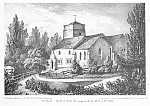



![]()
![]()

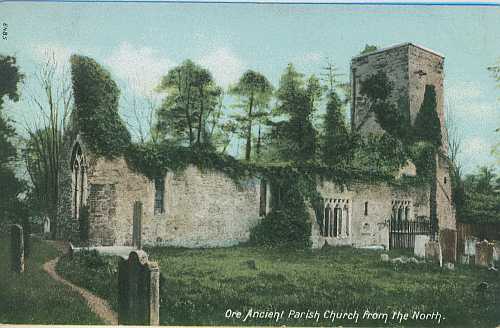




![]()